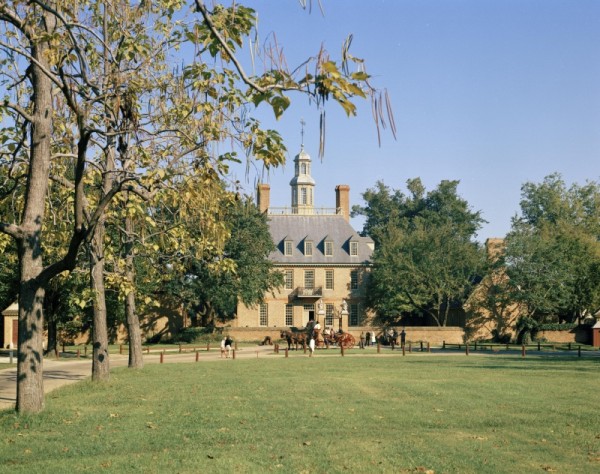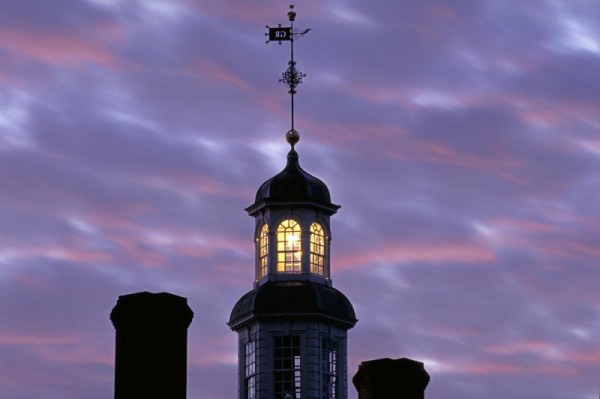 Virginians were very pleased with their very first palace in their new Williamsburg home. A professor from the College of William & Mary described the Williamsburg scene in 1724, when the Governor’s Palace was just 2 years old.
Virginians were very pleased with their very first palace in their new Williamsburg home. A professor from the College of William & Mary described the Williamsburg scene in 1724, when the Governor’s Palace was just 2 years old.
“From the Church,” he said, “runs a Street northward called Palace Street; at the other end of which stands the Palace or Governor’s House, a magnificent Structure built at the publick Expense, finished and beautified with Gates, Fine Gardens, Offices, Walks, a fine Canal, Orchards, &c…This likewise has the ornamental Addition of a good Cupola or Lanthorn…”
First, some background:
- It took 16 years to build the Governor’s Palace, which was completed in 1722.
- A contractor named Henry Cary began the project and was discharged for accounting irregularities. Another contractor, John Tyler, replaced him.
- The Governor’s Palace got its name even before it was finished. The term “Palace” was first used about 1714. Prior to that it was referred to as the Governor’s house.
- Considered humble by English standards, the last two royal governors had far grander accommodations in England.
- The Governor’s Palace was eventually home to seven royal governors and two from the newly minted nation (Patrick Henry and Thomas Jefferson).
Now, let’s dig a little deeper. Here are 10 things you may not know about the Governor’s Palace.
- Arms and other supplies from the Palace were used to fight in the French and Indian War – sometimes called the Seven Years’ War. A letter from Sir John St. Clair, a lieutenant colonel for the Royal American Regiment and responsible for the funds to pay for the troops’ supplies, stated that the Virginia Regiments needed blankets and arms. Those were supplied from the Governor’s Palace during Frances Fauquier’s term as acting governor in 1758.
- The interior stairs located in the center of the Palace were used by the servants, so they wouldn’t be seen moving through the main part of the house.
- The total square footage is more than 10,000, with three floors of approximately 3,380 square feet each.

- The cupola, or “lanthorn” was traditionally lit on birth nights and other “nights of occasional rejoicings.” The garden, lagoon and front green area can be seen from the cupola’s eight windows.
- After increasing tension with the rebellious patriot citizenry, the last of the royal governors – Lord Dunmore – fled with his family under cover of night on June 8, 1775, some two months after he seized the ammunition stored at the Magazine, sparking protests by the colonists.
- A year after the seat of government moved to Richmond in 1780, the Palace served as a hospital for American soldiers wounded in the Battle of Yorktown. It offered the possibility of survival to the wounded – if they could manage the long, rough carriage trip from Yorktown to Williamsburg. Unfortunately, many did not –156 Revolutionary War soldiers (154 men and two women) are buried in the garden.
- During a fire on Dec. 22, 1781, more than 100 wounded soldiers were evacuated from the building and one perished. The building burned to the ground in just three hours.
- The basement floor and one of the walls survived the 1781 fire and the original stone pavers still can be seen.
- During the Civil War, bricks from the fallen Palace building were used by Union soldiers to build chimneys for their houses during the 1862 occupation of Williamsburg.
- The area was completely reconstructed after the Civil War and the land passed to the College of William & Mary. Two school buildings stood on the Palace grounds at the time that the land was purchased in 1928 by the Colonial Williamsburg Foundation.
Reconstructed on top of the original foundation, the Palace reopened in 1934, based on Jefferson’s drawings, General Assembly records and a copperplate engraving discovered in the Bodleian Library in England.
Some 250,000 guests tour the Palace each year, continuing to learn about the historical significance of this remarkable building.

Leave a Reply